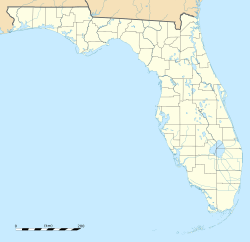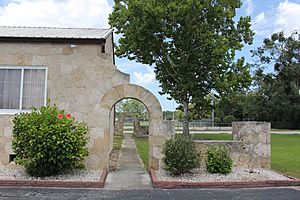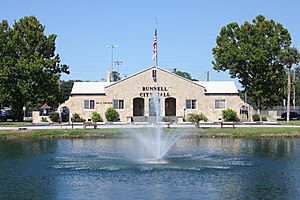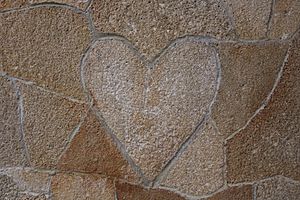Bunnell Coquina City Hall facts for kids
Quick facts for kids |
|
|
Bunnell City Hall
|
|
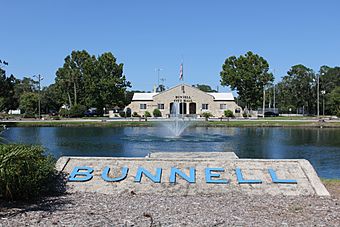
Bunnell Coquina City Hall - distant full front view with Lake Lucille & fountain
|
|
| Location | 200 South Church Street, Bunnell, Florida |
|---|---|
| Area | 2.946 acres |
| Built | 1936–1937 |
| Architectural style | WPA Rustic |
| MPS | Florida's New Deal Resources |
| NRHP reference No. | 100003406 |
| Added to NRHP | 4 February 2019 |
The Bunnell Coquina City Hall is a special building in Bunnell, Florida. It's also known as the Bunnell Civic Center or just Bunnell City Hall. This one-story building is made from a unique local stone called coquina. You can find it at 200 South Church Street in downtown Bunnell.
In front of the building is a man-made lake called Lake Lucille. It has a fountain that shoots water into the air, making the area look very pretty. The City Hall was built between 1936 and 1937. It received money from a government program called the WPA.
The Bunnell Coquina City Hall is important to the city's history. It gave the community a place to meet and have fun during a very tough time. This was during the Great Depression, when many people didn't have jobs or money. The building project also helped by giving jobs to many people who needed work. This helped the local economy a lot.
Contents
Building the City Hall
Building the City Hall started in 1936. A local builder named Zachary Dean Holland was in charge. He hired another local worker, John Swain, to help him. They hired anyone who needed a job, even if they had no building experience.
Working with coquina stone was tricky. It made the project slower than planned. On October 10, 1936, the WPA supervisor for the area allowed Holland to hire 40 more workers. This was to help finish the building by its goal date of January 1, 1937.
The building sits on a strong concrete base. Its outside walls are 13 inches thick and made of coquina stone. WPA workers shaped and smoothed the stones by hand using axes. You can still see the marks from their tools on many of the stones! The project was finished in early 1937. Then, the WPA gave the building to the City of Bunnell.
Building Style and Look
The City Hall has a special building style called WPA Rustic. This style uses local materials and building ideas from the area. It also has parts that look like Mission Revival architecture style. You can see this in its four arched walkways on the sides and the arched entrance at the front.
The top of the front porch inside is made of wood panels. All three entrances have strong coquina stone arches above them. A black sign above the front arches says "Bunnell City Hall." There's also a shield-shaped stone plaque built into the coquina. It says "WPA 1937," showing when it was finished.
The building's address, "200 S. Church," is also shown with black letters on the front. The windows on the front are modern sliding windows. They replaced the original wooden ones. All the windows also have coquina stone arches above them.
Lake Lucille
Lake Lucille is right in front of the Bunnell City Hall. It used to be a muddy area with cypress trees. But WPA workers dug it out by hand between 1936 and 1937. They used wheelbarrows to move the mud. This mud was then used to level the land behind the City Hall.
After digging, water was pumped in to create the oval-shaped lake. In the past, kids even had fishing contests in Lake Lucille! In the 1960s, a fountain was added to the middle of the lake. It creates a beautiful show of water and is a key part of the area's look. A paved road goes around Lake Lucille, so people can walk or drive to see it from different angles.
Inside the Building
Inside the City Hall, there's a big main room called the auditorium. Smaller rooms are on the sides and at the back. The auditorium walls are made of the same coquina stone, with its unique, uneven shapes. The windows also have coquina stone arches above them.
WPA workers even carved two fun shapes into the coquina stones inside. One is a heart, and the other is a dog's head! The floor is made of original pine wood that has been restored.
The office areas on the northwest and southwest sides have simple wooden doors from the auditorium. These rooms also have their original coquina stone walls. In the 1980s, a new ceiling was put in these rooms. It hides the air conditioning pipes and electrical wires. The original wooden ceiling and beams are now hidden.
At the back of the auditorium, there are two closets, a kitchen, and bathrooms for men and women. The kitchen has wooden cabinets, a stove, a refrigerator, and a new floor.
A Historic Place
The Bunnell Coquina City Hall is a very important historical building. On February 4, 2019, it was officially added to the National Register of Historic Places. This means it's recognized as a special place that should be protected because of its history and unique design.


